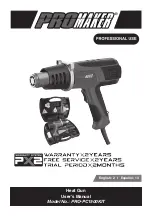
16
17
5.2.2
Withdrawable assembly
• The inspection should always include a visual
examination of the withdrawable part assembly.
Special attention is to be paid to those parts
which may possibly be damaged by improper
handling. (See section “Inspection/Circuit-breaker
in general“.)
• Visual checking of the isolating contact system.
We recommend turning the contact system alter-
nately in order to clean the inner contact points.
The contact points should be cleaned if signs of
impermissible overheating (discoloured surface)
are visible (see section “Repairs“).
• The interlock conditions and the ease of move
-
ment of the lock and release device are to be
checked as described under “Repairs“.
When checking the interlock conditions, it is
essential to ensure that no force is used.
Maximum torque 25 Nm!
5.3
Servicing
Cleaning surfaces:
If, on the occasion of an inspection in accordance
with (5.2), the necessity of cleaning measures has
been established, proceed as follows:
• Before cleaning, where required, the working
area must be switched off and secured against
reconnection in accordance with the „Safety
Regulations“ specified by DIN VDE/IEC.
• Cleaning the surfaces in general:
– Poorly adhering dry dust residues with a soft
dry cloth.
– More strongly adhering grime with mildly al-
kaline household cleaner or with Rivolta BWR
210.
• Cleaning insulating surfaces and conductive
components:
– Minor grime with Rivolta BWR 210.
– Strongly adhering grime with cold cleanser
716.
• Observe the manufacturers’ directions and in
particular ABB operating instructions BA 1002/E
and BA 1006/E on safety at work.
• After cleaning, rinse with clean water and dry
carefully.
• Should external discharges occur as a result of
condensation, application of a thin silicone film on
the surface concerned is often effective as a tem-
porary remedy. It is advisable to request advice
from the ABB after-sales service department on
permanent solutions to such unusual problems.
For details of servicing, see also the relevant sec-
tions of manual BA 359.
5.4
Repairs
5.4.1
Switchgear in general
Repair of surface damage:
• Sheet steel parts, painted:
– Remove rust, e.g. with a wire brush.
– Grind off paint coat and degrease.
– Apply anti-rust primer and top coat.
– Use top coat paint in the standard colour
RAL 7035.
• Sheet steel parts, with zinc surface and passiva
-
ted functional parts:
– Remove white rust with a wire brush or
cleaning pad (e.g. Scotch-Brite white).
– Remove loosely adhering particles with a dry
cloth.
– Apply zinc spray or zinc dust primer.
• Functional parts, phosphated:
– Remove rust with a wire brush or cleaning
pad (e.g. Scotch-Brite white).
– Clean with a dry cloth.
– Grease with Isoflex Topas NB 52.
Switchgear in general:
• Observe the maintenance instructions in the ma
-
nuals for the individual equipment components.
• Check that the bolt connections at the contact
points in the busbar system and the earth con-
nections are tight, and that the isolating contact
system functions correctly.
• Regrease the contact points and mechanism
of the withdrawable part insertion system as
necessary, or, when lubrication is inadequate or
missing, thoroughly clean the areas concerned
and regrease with Isoflex Topas NB 52 lubricant.
• Where required, regrease or thoroughly clean
slide plates and bearings in the panel and regrea-
se them with Isoflex NB 52 lubricant.
Remove the contact system for thoroughly
cleaning as described below (Figure 5/1):
– Slide the two inner annular tension springs (4.4)
facing the breaker pole to a position beside the
other two outer annual tension springs, thus
releasing contact system (4.3), and remove the
contact system from contact arm.
– Fit a new contact system back to front on the
thin end of arbor (127), and slide it forwards
onto the thicker part of the shank.
– Fit arbor (127) onto the relevant contact arm,
slide the contact system (4.3) over onto the
contact arm, and withdraw the arbor.
– Check all contact fingers and annular tension
springs for perfect fit.
Note:
The set installation position of contact arms
must not be changed by the improper use
of force.
BA 414-07_GB_AMC.indd 16
18.07.12 10:25
Summary of Contents for VD4 Series
Page 2: ......













































